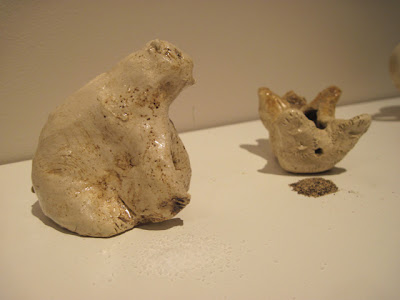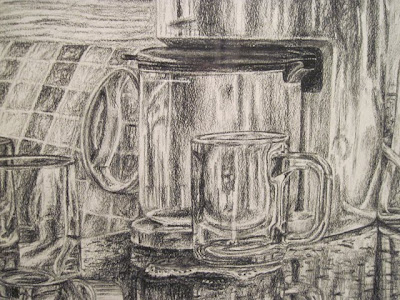Gregg Fleishman's show, "Cubism," is up at the Tahoe Gallery through November 17th. There's something stubbornly literal about the title. The show has nothing to do with the illusionistic representation of three dimensions on a two dimensional plane. "Cubism" in its art-historical flavors -- analytic or synthetic -- isn't the purview of the work. If the type of cubism could be tagged here, maybe "functional cubism" would do. Fleishman is interested in the architectural possibilities of cubic forms, their adaptability and modularity (and also their beauty, but I suspect that, for Fleishman, their beauty is a direct extension of their adaptability and modularity).

 Fleishman
Fleishman, in his artist's talk, revealed a mind at absolute ease in the manicured wilds of geometry. Not everyone is able to sensibly incorporate "icosehedrons" and
"archimidean solids" into their patter. And I get the impression that those words don't just tumble out of his mouth when he's giving a speech. For him, I suspect they amount to an everyday argot. His vocabulary has the recklessly technical clarity of a specialist or an autodidact -- and it's sprinkled, too, with the autodidact's propensity for new coinages -- like
"rhombicube."("Rhombicube" has a nice ring to it, especially when set against the term it's meant to simplify: "rhombicuboctahedron.")





As mentioned above, the modularity of the forms Fleishman works with is a big part of their appeal. The architectural structures he creates seem to multiply outward, from an implacable recombinatory logic. A shape multiplies, like an apartment growing out of an expanding crystal formation. There's a self-sufficiency of means, as the structures hinge together via tab and slot systems. On a graphical level, I was reminded of M. C. Escher, who used the six-paned window of the cube to free the eye from gravity and unitary perspective. On a procedural level, I was reminded of Albers and
Sol Le Witt, in their patience for playing variations on a theme -- using a finite number of elements to point toward infinity.




In the gallery, I was particularly taken by the work's tendency to re-frame itself. Portals and windows cropped interiors or other structures in gratifying ways.

The work isn't just "art stuff" -- it's designed to be deployed, used, inhabited. Fleishman intends for his larger structures to be used as housing for disaster relief (so the modularity and self-sufficiency aren't just aesthetic gestures). His studio in Culver City is close to a school, and he's designed charming playgrounds for it. He claimed the play structures were "incidental" to his practice, but honestly, the playfulness of the use seems perfectly wedded to the playfulness of design.
More recently, a structure of his was
erected at Burning Man -- Black Rock being, as he framed it, a place in need of sudden infrastructures.





Below are a few pics taken the night of the reception and artists' talk. The night of the reception, there was a bit of a playground vibe to the gallery. Students climbed up the large structure, and tried to piece together elements of some of the smaller structures, while Fleishman looked benevolently on, sometimes giving hints.
When Fleishman asked how long it took for the gallery crew to put together the large structure in the gallery, Russell said (if I'm remembering correctly) "four or five hours." There was a beat and Fleishman said "That's too long."


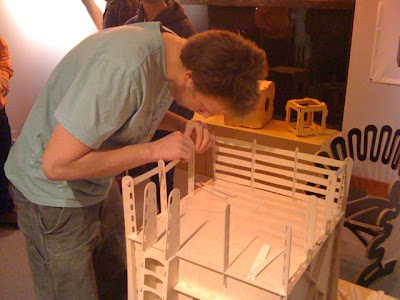


The last pic is Sheri, beaming over her latest acquisitions: some tiny squiggly chairs designed by Fleishman, scaled to the size (if not the comfort) of a mouse. She already had one in her collection, but couldn't resist a couple more, especially because they're cheaper now that Fleishman is using computers in his production workflow -- no longer cutting the serpentines by hand.
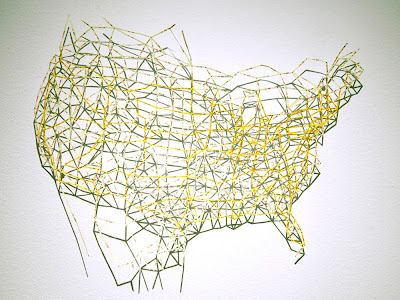
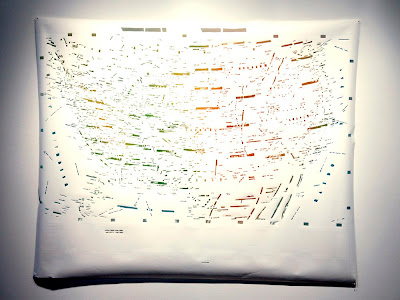
 Jeanne-Claude, Christo’s Collaborator on Environmental Canvas, Is Dead at 74
Jeanne-Claude, Christo’s Collaborator on Environmental Canvas, Is Dead at 74 









